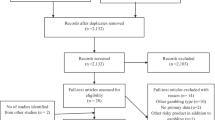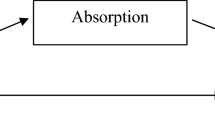Abstract
This study used simulations to examine the effect of prize structure on the outcome volatility and the number of winners of various game configurations. The two most common prize structures found in gambling games are even money payoff games (bet $1; win $2) found on most table games and multilevel prizes structures found in gambling machine games. Simulations were set up to examine the effect of prize structure on the long-term outcomes of these games. Eight different prize structures were compared in terms of the number of winners and volatility. It was found that the standard table game and commercial gambling machines produced fairly high numbers of short term winners (1 h), but few long term winners (50 h). It was found that the typical even money game set up produced the lowest level of volatility. Of the multilevel prize structures examined, the three simulations based on commercial gambling machines were the least volatile. The results are examined in terms of the pragmatics of game design.





Similar content being viewed by others
Notes
Note this assumes a speed of one spin per 6 s. Both the spin rate and house edge estimate are fairly conservative figures. Some machines can be played faster and some machines take a larger house edge.
References
Breen, R. B., & Zimmerman, M. (2002). Rapid onset of pathological gambling in machine gamblers. Journal of Gambling Studies, 18, 31–43.
Canadian Gambling Digest. (2007). Canadian partnership for responsible gambling downloaded November 30, 2009, from www.cprg.ca/articles/Canadian_Gambling_Digest_2005_2006.pdf.
Cardoza, A. (1997). How to win at gambling. New York: Cardoza Publishing.
Cohen, J. (1988). Statistical power analysis for the behavioural sciences. Hillsdale, NJ: Lawrence Erlbaum Associates.
Counter, A., & Davey, B. (2006). What is the Ontario problem gambling helpline (OPGH)? Paper presented at the conference of the Responsible Gambling Council (Ontario), Toronto. Retrieved July 16, 2008, from www.rgco.org/articles/anne_counter_brad_davey_discovery_2006.pdf.
Delfabbro, H. H., & Winefield, A. H. (1999). Poker-machine gambling: An analysis of within session characteristics. British Journal of Psychology, 90(3), 425–439.
Dickerson, M. (1996). Why ‘slots’ equals ‘grind’ in any language: The cross-cultural popularity of the slot machine. In J. McMillen (Ed.), Gambling cultures: Studies in history and interpretation (pp. 152–166). London: Routledge.
Dickerson, M., Hinchy, J., England, S. L., & Fabre, J. (1992). On the determinants of persistent gambling behaviour. I. High frequency poker machine players. British Journal of Psychology, 83, 237–248.
Dixon, M. R., MacLin, O. H., & Daugherty, D. (2006). An evaluation of response allocations to concurrently available slot machine simulations. Behavior Research Methods, 38(2), 232–236.
Dorion, J. P., & Nicki, R. M. (2001). Epidemiology of problem gambling in Prince Edward Island: A Canadian microcosm. Canadian Journal of Psychiatry, 46, 413–417.
Dowling, N., Smith, D., & Thomas, T. (2004). Electronic gaming machines: Are they the ‘crack-cocaine’ of gambling? Addiction, 100, 33–45.
Ernkvist, M. (2009). Creating player appeal: Management of technological innovation and changing pattern of industrial leadership in the U.S. gaming machine manufacturing industry, 1965–2005. Goteberg, Sweden: University of Gothenburg.
G2E. (2009). Preview to the 2009 Global Gaming Expo, Las Vegas. Retrieved December 9, 2009, from http://content.yudu.com/Library/A1go7o/G2EPreview2009/resources/1.htm.
Harrigan, K. A. (2007). Slot machine structural characteristics: Distorted player views of payback percentages. Journal of Gambling Issues, (20). Downloaded January 9, 2007, from www.camh.net/egambling.
Harrigan, K. A., & Dixon, M., (2009). PAR Sheets, probabilities, and slot machine play: Implications for problem and non-problem gambling. Journal of Gambling Issues, 23. http://www.camh.net/egambling/issue23/06harrigan.html.
Haruvy, E., Erev, L., & Sonsino, D. (2001). The medium prizes paradox: Evidence from a simulated casino. The Journal of Risk and Uncertainty, 22(3), 251–261.
IGT. (2009). Slotline. Show Edition, November 2009. Nevada: IGT.
Kilby, J., Fox, J., & Lucas, A. F. (2004). Casino operations management (2nd ed.). New York: Wiley.
MacDonald, A., & Eadington, W.R. (2007). Bright ideas: “Knowledge should defeat fear”—understanding the high stakes game of Baccarat—Part II. Retrieved January 22, 2010, from www.urbino.net/bright.cfm?specificBright=%E2%80%9CKnowledge%20Should%20Defeat%20Fear%E2%80%9D%20%E2%80%93%20Understanding%20the%20high%20stakes%20game%20of%20Baccarat%20-%20Part%20II.
Mizerski, D., Jolley, B., & Mizerski, K. (2002). Disputing the “crack cocaine of gambling” label for electronic gaming machines. Paper presented at the National Association for Gambling Studies, Sydney.
OLG. (2010). Lotto 649. Retrieved June 7, 2010, from http://www.olg.ca/lotteries/games/howtoplay.do?game=lotto649.
Productivity Commission. (1999). Australia’s gambling industries. Report no. 10. Canberra, Australia: AusInfo.
Schull, N. D. (2005). Digital gambling: The coincidence of desire and design. Annals of the American Academy of Political and Social Science, 597, 65–81.
Turner, N. E., & Ferentzy, P. (2010). The natural life history of a lottery: The importance of large wins in the establishment and survival of a lottery. International Gambling Studies, 10(1), 19–30.
Turner, N. E., & Horbay, R. (2003). Doubling revisited: The mathematical and psychological effect of betting strategy. Gambling Research, 15, 16–34.
Turner, N. E., & Horbay, R. (2004). How do slot machines and other electronic gambling machines actually work? Journal of Gambling Issue, (11), 10–50. http://www.camh.net/egambling/issue11/index.html.
Urbanoski, K. A., & Rush, B. R. (2006). Characteristics of people seeking treatment for problem gambling in Ontario: Trends from 1998–2002. Electronic Journal of Gambling Issues, 16, 77–97 [Online]. Retrieved July 16, 2008, from www.camh.net/egambling/issue16.
Weatherly, J. N., & Brandt, A. E. (2004). Participants’ sensitivity to percentage payback and credit value when playing a slot-machine simulation. Behavior and Social Issues, 13, 33–50.
Acknowledgments
Support to CAMH for salary of scientists and infrastructure has been provided by the Ontario Ministry of Health and Long Term Care (OMHLTC).
Author information
Authors and Affiliations
Corresponding author
Additional information
The project involved simulations and therefore did not require an ethics review. The ideas expressed are those of the authors and do not necessarily reflect those of the Centre for Addiction and Mental Health (CAMH), the University of Toronto or OMHLTC.
Rights and permissions
About this article
Cite this article
Turner, N.E. Volatility, House Edge and Prize Structure of Gambling Games. J Gambl Stud 27, 607–623 (2011). https://doi.org/10.1007/s10899-011-9238-0
Published:
Issue Date:
DOI: https://doi.org/10.1007/s10899-011-9238-0




